我們在操作一個調和時都 是通過open系統調用先去打開這個設備,不管是設備還是文件,我們要訪問它都要稱通過open函數來先打開, 這樣才能調用其它的函數如read、write來操作它,即通知內核新建一個代表該文件的結構,并且返回該文件的描述符(一個整數),該描述符在進程內唯一。
在Linux系統進程中,分為內核空間和用戶空間,當一個任務(進程)執行系統調用而陷入內核代碼中執行時,我們就稱進程處于內核運行態(內核態)。在內核態下,CPU可執行任何指令。當進程在執行用戶自己的代碼時,則稱其處于用戶運行態(用戶態)。用戶態不能訪問內核空間,包括代碼和數據。所有進程的內核空間(3G-4G)都是共享的。當我們在用戶空間調用open之后,會產生一個軟中斷,然后通過系統調用進入內核空間。通過系統調用號,我們就可以跳轉到該中斷例程的入口地址。
這里分析一下open的調用流程.
open()的格式如下:
int open(const char * pathname,int oflag, mode_t mode )
pathname:代表需要打開的文件的文件名;
oflag:表示打開的標識,具體的內核支持如下標記位(includeasm-genericfcntl.h):
[cpp]?view plain?copy
#define?O_ACCMODE???00000003??
#define?O_RDONLY????00000000??//只讀打開??
#define?O_WRONLY????00000001??//只寫打開??
#define?O_RDWR??????00000002??//讀寫打開??
#ifndef?O_CREAT??
#define?O_CREAT?????00000100????//文件不存在則創建,需要mode_t??
#endif??
#ifndef?O_EXCL??
#define?O_EXCL??????00000200????//如果同時指定了O_CREAT,而文件已經存在,則出錯???
#endif??
#ifndef?O_NOCTTY??
#define?O_NOCTTY????00000400????//如果pathname代表終端設備,則不將此設備分配作為此進程的控制終端??
#endif??
#ifndef?O_TRUNC??
#define?O_TRUNC?????00001000????//如果此文件存在,而且為只讀或只寫成功打開,則將其長度截短為0???
#endif??
#ifndef?O_APPEND??
#define?O_APPEND????00002000????//每次寫時都加到文件的尾端??
#endif??
#ifndef?O_NONBLOCK??
#define?O_NONBLOCK??00004000?????//如果pathname指的是一個FIFO、一個塊特殊文件或一個字符特殊文件,則此選擇項為此文件的本次打開操作和后續的I?/?O操作設置非阻塞??
#endif??
#ifndef?O_SYNC??
#define?O_SYNC??????00010000????//使每次write都等到物理I/O操作完成??
#endif??
#ifndef?FASYNC??
#define?FASYNC??????00020000????//兼容BSD的fcntl同步操作??
#endif??
#ifndef?O_DIRECT??
#define?O_DIRECT????00040000????//直接磁盤操作標識,每次讀寫都不使用內核提供的緩存,直接讀寫磁盤設備??
#endif??
#ifndef?O_LARGEFILE??
#define?O_LARGEFILE?00100000????//?大文件標識??
#endif??
#ifndef?O_DIRECTORY??
#define?O_DIRECTORY?00200000????//必須是目錄??
#endif??
#ifndef?O_NOFOLLOW??
#define?O_NOFOLLOW??00400000????//不獲取連接文件??
#endif??
#ifndef?O_NOATIME??
#define?O_NOATIME???01000000??
#endif??
#ifndef?O_CLOEXEC??
#define?O_CLOEXEC???02000000????/*?set?close_on_exec?*/??
#endif??
#ifndef?O_NDELAY??
#define?O_NDELAY????O_NONBLOCK??
#endif??
當新創建一個文件時,需要指定mode參數,以下說明的格式如宏定義名稱<實際常數值>:
?描述如下(includelinuxstat.h):
[cpp]?view plain?copy
#define?S_IRWXU?00700???//文件擁有者有讀寫執行權限??
#define?S_IRUSR?00400???//文件擁有者僅有讀權限??????
#define?S_IWUSR?00200???//文件擁有者僅有寫權限??
#define?S_IXUSR?00100???//文件擁有者僅有執行權限??
#define?S_IRWXG?00070???//組用戶有讀寫執行權限??
#define?S_IRGRP?00040???//組用戶僅有讀權限??
#define?S_IWGRP?00020???//組用戶僅有寫權限??
#define?S_IXGRP?00010???//組用戶僅有執行權限??
#define?S_IRWXO?00007???//其他用戶有讀寫執行權限??
#define?S_IROTH?00004???//其他用戶僅有讀權限??
#define?S_IWOTH?00002???//其他用戶僅有寫權限??
#define?S_IXOTH?00001???//其他用戶僅有執行權限??
系統調用號定義在arch/x86/include/asm/unistd_32.h中:
[cpp]?view plain?copy
#define?__NR_restart_syscall??????0??
#define?__NR_exit?????????1??
#define?__NR_fork?????????2??
#define?__NR_read?????????3??
#define?__NR_write????????4??
#define?__NR_open?????????5??
#define?__NR_close????????6??
#define?__NR_waitpid??????????7??
#define?__NR_creat????????8??
#define?__NR_link?????????9??
#define?__NR_unlink??????10??
#define?__NR_execve??????11??
#define?__NR_chdir???????12??
#define?__NR_time????????13??
#define?__NR_mknod???????14??
#define?__NR_chmod???????15??
當open系統調用產生時,就會進入下面這個函數():
[cpp]?view plain?copy
SYSCALL_DEFINE3(open,?const?char?__user?*,?filename,?int,?flags,?int,?mode)??
{??
long?ret;??
/*檢查是否應該不考慮用戶層傳遞的標志、總是強行設置??
O_LARGEFILE標志。如果底層處理器的字長不是32位,就是這種??
情況*/???
if?(force_o_largefile())??
flags?|=?O_LARGEFILE;??
/*實際工作*/???
ret?=?do_sys_open(AT_FDCWD,?filename,?flags,?mode);??
/*?avoid?REGPARM?breakage?on?x86:?*/??
asmlinkage_protect(3,?ret,?filename,?flags,?mode);??
return?ret;??
}??
我們看下SYSCALL_DEFINE3(open, const char __user *, filename, int, flags, int, mode) 展開是怎么樣的
首先看下宏SYSCALL_DEFINE3
[cpp]?view plain?copy
#define?SYSCALL_DEFINE3(name,?...)?SYSCALL_DEFINEx(3,?_##name,?__VA_ARGS__)??
再看下SYSCALL_DEFINEx
[cpp]?view plain?copy
#define?SYSCALL_DEFINEx(x,?sname,?...)????????????????
__SYSCALL_DEFINEx(x,?sname,?__VA_ARGS__)??
再看下__SYSCALL_DEFINEx ??
[cpp]?view plain?copy
#define?__SYSCALL_DEFINEx(x,?name,?...)???????????????????
asmlinkage?long?sys##name(__SC_DECL##x(__VA_ARGS__))??
這里對對應__SC_DECL3
[cpp]?view plain?copy
#define?__SC_DECL1(t1,?a1)??t1?a1??
#define?__SC_DECL2(t2,?a2,?...)?t2?a2,?__SC_DECL1(__VA_ARGS__)??
#define?__SC_DECL3(t3,?a3,?...)?t3?a3,?__SC_DECL2(__VA_ARGS__)??
這們一步步展開SYSCALL_DEFINE3(open, const char __user *, filename, int, flags, int, mode)代替進去,可以得到?
[cpp]?view plain?copy
SYSCALL_DEFINE3(open,?const?char?__user?*,?filename,?int,?flags,?int,?mode)??
=?SYSCALL_DEFINEx(3,?_##name,?__VA_ARGS__)???
=asmlinkage?long?sys_open(__SC_DECL3(__VA_ARGS__))??
=asmlinkage?long?sys_open(const?char?__user*?filename,?int?flags,?int?mode)??
這個才是真正的函數原型
在sys_open里面繼續調用do_sys_open完成 open操作
[cpp]?view plain?copy
long?do_sys_open(int?dfd,?const?char?__user?*filename,?int?flags,?int?mode)??
{??
/*從進程地址空間讀取該文件的路徑名*/????
char?*tmp?=?getname(filename);??
int?fd?=?PTR_ERR(tmp);??
if?(!IS_ERR(tmp))?{??
/*在內核中,每個打開的文件由一個文件描述符表示??
該描述符在特定于進程的數組中充當位置索引(數組是??
task_struct->files->fd_arry),該數組的元素包含了file結構,其中??
包括每個打開文件的所有必要信息。因此,調用下面??
函數查找一個未使用的文件描述符,返回的是上面??
說的數組的下標*/????
fd?=?get_unused_fd_flags(flags);??
if?(fd?>=?0)?{??
/*fd獲取成功則開始打開文件,此函數是主要完成打開功能的函數*/??
//如果分配fd成功,則創建一個file對象??
struct?file?*f?=?do_filp_open(dfd,?tmp,?flags,?mode,?0);??
if?(IS_ERR(f))?{??
put_unused_fd(fd);??
fd?=?PTR_ERR(f);??
}?else?{??
/*文件如果打開成功,調用fsnotify_open()函數,根據inode所指定的信息進行打開?
函數(參數為f)將該文件加入到文件監控的系統中。該系統是用來監控文件被打開,創建,?
讀寫,關閉,修改等操作的*/???
fsnotify_open(f->f_path.dentry);??
/*將文件指針安裝在fd數組中?
將struct?file?*f加入到fd索引位置處的數組中。如果后續過程中,有對該文件描述符的?
操作的話,就會通過查找該數組得到對應的文件結構,而后在進行相關操作。*/??
fd_install(fd,?f);??
}??
}??
putname(tmp);??
}??
return?fd;??
}??
該函數主要分為如下幾個步驟來完成打開文件的操作:
1.將文件名參數從用戶態拷貝至內核,調用函數get_name();
2.從進程的文件表中找到一個空閑的文件表指針,調用了函數get_unused_fd_flgas();
3.完成真正的打開操作,調用函數do_filp_open();
4.將打開的文件添加到進程的文件表數組中,調用函數fd_install();
getname函數主要的任務是將文件名filename從用戶態拷貝至內核態
[cpp]?view plain?copy
char?*?getname(const?char?__user?*?filename)??
{??
char?*tmp,?*result;??
result?=?ERR_PTR(-ENOMEM);??
tmp?=?__getname();?//從內核緩存中分配空間;????
if?(tmp)??{??
//將文件名從用戶態拷貝至內核態;???
int?retval?=?do_getname(filename,?tmp);??
result?=?tmp;??
if?(retval?
__putname(tmp);??
result?=?ERR_PTR(retval);??
}??
}??
audit_getname(result);??
return?result;??
}??
get_unused_fd_flags實際調用的是alloc_fd
[cpp]?view plain?copy
#define?get_unused_fd_flags(flags)?alloc_fd(0,?(flags))??
[cpp]?view plain?copy
/*?
*?allocate?a?file?descriptor,?mark?it?busy.?
*/??
int?alloc_fd(unsigned?start,?unsigned?flags)??
{??
struct?files_struct?*files?=?current->files;//獲得當前進程的files_struct?結構??
unsigned?int?fd;??
int?error;??
struct?fdtable?*fdt;??
spin_lock(&files->file_lock);??
repeat:??
fdt?=?files_fdtable(files);??
fd?=?start;??
if?(fd?next_fd)?//從上一次打開的fd的下一個fd開始搜索空閑的fd????
fd?=?files->next_fd;??
if?(fd?max_fds)//尋找空閑的fd,返回值為空閑的fd????
fd?=?find_next_zero_bit(fdt->open_fds->fds_bits,??
fdt->max_fds,?fd);??
//如果有必要,即打開的fd超過max_fds,則需要expand當前進程的fd表;????
//返回值error<0表示出錯,error=0表示無需expand,error=1表示進行了expand;??
error?=?expand_files(files,?fd);??
if?(error?
goto?out;??
/*?
*?If?we?needed?to?expand?the?fs?array?we?
*?might?have?blocked?-?try?again.?
*/??
//error=1表示進行了expand,那么此時需要重新去查找空閑的fd;????
if?(error)??
goto?repeat;??
//設置下一次查找的起始fd,即本次找到的空閑的fd的下一個fd,記錄在files->next_fd中;????
if?(start?<=?files->next_fd)??
files->next_fd?=?fd?+?1;??
FD_SET(fd,?fdt->open_fds);??
if?(flags?&?O_CLOEXEC)??
FD_SET(fd,?fdt->close_on_exec);??
else??
FD_CLR(fd,?fdt->close_on_exec);??
error?=?fd;??
#if?1??
/*?Sanity?check?*/??
if?(rcu_dereference(fdt->fd[fd])?!=?NULL)?{??
printk(KERN_WARNING?"alloc_fd:?slot?%d?not?NULL! ",?fd);??
rcu_assign_pointer(fdt->fd[fd],?NULL);??
}??
#endif??
out:??
spin_unlock(&files->file_lock);??
return?error;??
}??
該函數為需要打開的文件在當前進程內分配一個空閑的文件描述符fd,該fd就是open()系統調用的返回值
do_filp_open函數的一個重要作用就是根據傳遞近來的權限進行分析,并且分析傳遞近來的路徑名字,根據路徑名逐個解析成dentry,并且通過dentry找到inode,inode就是記錄著該文件相關的信息, 包括文件的創建時間和文件屬性所有者等等信息,根據這些信息就可以找到對應的文件操作方法。在這個過程當中有一個臨時的結構體用于保存在查找過程中的相關信息,就是
[cpp]?view plain?copy
struct?nameidata?{??
struct?path?path;//當前目錄的dentry數據結構??
struct?qstr?last;//這個結構體也是臨時性的,主要用來保存當前目錄的名稱,雜湊值。??
unsigned?int????flags;??
int?????last_type;??
unsigned????depth;//連接文件的深度(可能一個連接文件跟到最后還是一個了連接文件)??
//用來保存連接文件的一些信息,下標表示連接文件的深度??
char?*saved_names[MAX_NESTED_LINKS?+?1];??
/*?Intent?data?*/??
union?{??
struct?open_intent?open;??
}?intent;??
};??
[cpp]?view plain?copy
struct?file?*do_filp_open(int?dfd,?const?char?*pathname,??
int?open_flag,?int?mode,?int?acc_mode)??
{??
struct?file?*filp;??
struct?nameidata?nd;??
int?error;??
struct?path?path;??
int?count?=?0;??
int?flag?=?open_to_namei_flags(open_flag);?/*改變參數flag的值,具體做法是flag+1*/???
int?force_reval?=?0;??
if?(!(open_flag?&?O_CREAT))??
mode?=?0;??
/*?
*?O_SYNC?is?implemented?as?__O_SYNC|O_DSYNC.??As?many?places?only?
*?check?for?O_DSYNC?if?the?need?any?syncing?at?all?we?enforce?it's?
*?always?set?instead?of?having?to?deal?with?possibly?weird?behaviour?
*?for?malicious?applications?setting?only?__O_SYNC.?
*/??
if?(open_flag?&?__O_SYNC)/*根據__O_SYNC標志來設置O_DSYNC?標志,用以防止惡意破壞程序*/???
open_flag?|=?O_DSYNC;??
if?(!acc_mode)/*設置訪問權限*/???
acc_mode?=?MAY_OPEN?|?ACC_MODE(open_flag);??
/*?O_TRUNC?implies?we?need?access?checks?for?write?permissions?*/??
if?(open_flag?&?O_TRUNC)/*根據?O_TRUNC標志設置寫權限?*/???
acc_mode?|=?MAY_WRITE;??
/*?Allow?the?LSM?permission?hook?to?distinguish?append??
access?from?general?write?access.?*/??
if?(open_flag?&?O_APPEND)/*?設置O_APPEND?標志*/????
acc_mode?|=?MAY_APPEND;??
/*?find?the?parent?*/??
reval:??
error?=?path_init(dfd,?pathname,?LOOKUP_PARENT,?&nd);//初始化nd??
if?(error)??
return?ERR_PTR(error);??
if?(force_reval)??
nd.flags?|=?LOOKUP_REVAL;??
current->total_link_count?=?0;??
error?=?link_path_walk(pathname,?&nd);//路徑名解析函數,將一個路徑名最終轉化為一個dentry??
if?(error)?{??
filp?=?ERR_PTR(error);??
goto?out;??
}??
if?(unlikely(!audit_dummy_context())?&&?(open_flag?&?O_CREAT))??
audit_inode(pathname,?nd.path.dentry);??
/*?
*?We?have?the?parent?and?last?component.?
*/??
error?=?-ENFILE;??
filp?=?get_empty_filp();//?從進程文件表中獲取一個未使用的文件結構指針,空則出錯返回??
if?(filp?==?NULL)??
goto?exit_parent;??
nd.intent.open.file?=?filp;??
filp->f_flags?=?open_flag;??
nd.intent.open.flags?=?flag;??
nd.intent.open.create_mode?=?mode;??
nd.flags?&=?~LOOKUP_PARENT;??
nd.flags?|=?LOOKUP_OPEN;??
if?(open_flag?&?O_CREAT)?{??
nd.flags?|=?LOOKUP_CREATE;??
if?(open_flag?&?O_EXCL)??
nd.flags?|=?LOOKUP_EXCL;??
}??
if?(open_flag?&?O_DIRECTORY)??
nd.flags?|=?LOOKUP_DIRECTORY;??
if?(!(open_flag?&?O_NOFOLLOW))??
nd.flags?|=?LOOKUP_FOLLOW;??
filp?=?do_last(&nd,?&path,?open_flag,?acc_mode,?mode,?pathname);//返回一個file結構??
while?(unlikely(!filp))?{?/*?trailing?symlink?*///符號鏈接??
struct?path?holder;??
struct?inode?*inode?=?path.dentry->d_inode;??
void?*cookie;??
error?=?-ELOOP;??
/*?S_ISDIR?part?is?a?temporary?automount?kludge?*/??
if?(!(nd.flags?&?LOOKUP_FOLLOW)?&&?!S_ISDIR(inode->i_mode))??
goto?exit_dput;??
if?(count++?==?32)??
goto?exit_dput;??
/*?
*?This?is?subtle.?Instead?of?calling?do_follow_link()?we?do?
*?the?thing?by?hands.?The?reason?is?that?this?way?we?have?zero?
*?link_count?and?path_walk()?(called?from?->follow_link)?
*?honoring?LOOKUP_PARENT.??After?that?we?have?the?parent?and?
*?last?component,?i.e.?we?are?in?the?same?situation?as?after?
*?the?first?path_walk().??Well,?almost?-?if?the?last?component?
*?is?normal?we?get?its?copy?stored?in?nd->last.name?and?we?will?
*?have?to?putname()?it?when?we?are?done.?Procfs-like?symlinks?
*?just?set?LAST_BIND.?
*/??
nd.flags?|=?LOOKUP_PARENT;??
error?=?security_inode_follow_link(path.dentry,?&nd);??
if?(error)??
goto?exit_dput;??
error?=?__do_follow_link(&path,?&nd,?&cookie);//查找符號鏈接對應的目錄中的最后一項??
if?(unlikely(error))?{??
/*?nd.path?had?been?dropped?*/??
if?(!IS_ERR(cookie)?&&?inode->i_op->put_link)??
inode->i_op->put_link(path.dentry,?&nd,?cookie);??
path_put(&path);??
release_open_intent(&nd);??
filp?=?ERR_PTR(error);??
goto?out;??
}??
holder?=?path;??
nd.flags?&=?~LOOKUP_PARENT;??
filp?=?do_last(&nd,?&path,?open_flag,?acc_mode,?mode,?pathname);??
if?(inode->i_op->put_link)??
inode->i_op->put_link(holder.dentry,?&nd,?cookie);??
path_put(&holder);??
}??
out:??
if?(nd.root.mnt)??
path_put(&nd.root);??
if?(filp?==?ERR_PTR(-ESTALE)?&&?!force_reval)?{??
force_reval?=?1;??
goto?reval;??
}??
return?filp;//成功,返回??
exit_dput:??
path_put_conditional(&path,?&nd);??
if?(!IS_ERR(nd.intent.open.file))??
release_open_intent(&nd);??
exit_parent:??
path_put(&nd.path);??
filp?=?ERR_PTR(error);??
goto?out;??
}??
當內核要訪問一個文件的時候,第一步要做的是找到這個文件,而查找文件的過程在vfs里面是由link_path_walk函數來完成的,在path_init的時候我們可以看到傳進去的參數有一個LOOKUP_PARENT,它的含義是查找最后一個分量名所在的目錄。也就是當這個函數返回的時候,我們得到了一個路徑名中最后一個分量所在的目錄。
接著調用do_last返回最后一個分量對應的file指針,我們關注一下這個函數
[cpp]?view plain?copy
static?struct?file?*do_last(struct?nameidata?*nd,?struct?path?*path,??
int?open_flag,?int?acc_mode,??
int?mode,?const?char?*pathname)??
{??
struct?dentry?*dir?=?nd->path.dentry;??
struct?file?*filp;??
int?error?=?-EISDIR;??
switch?(nd->last_type)?{//?檢查最后一段文件或目錄名的屬性情況??
case?LAST_DOTDOT:??
follow_dotdot(nd);??
dir?=?nd->path.dentry;??
case?LAST_DOT:??
if?(nd->path.mnt->mnt_sb->s_type->fs_flags?&?FS_REVAL_DOT)?{??
if?(!dir->d_op->d_revalidate(dir,?nd))?{??
error?=?-ESTALE;??
goto?exit;??
}??
}??
/*?fallthrough?*/??
case?LAST_ROOT:??
if?(open_flag?&?O_CREAT)??
goto?exit;??
/*?fallthrough?*/??
case?LAST_BIND:??
audit_inode(pathname,?dir);??
goto?ok;??
}??
/*?trailing?slashes??*/??
if?(nd->last.name[nd->last.len])?{??
if?(open_flag?&?O_CREAT)??
goto?exit;??
nd->flags?|=?LOOKUP_DIRECTORY?|?LOOKUP_FOLLOW;??
}??
/*?just?plain?open??*/??
if?(!(open_flag?&?O_CREAT))?{//沒有創建標志,即文件存在??
error?=?do_lookup(nd,?&nd->last,?path);//找到路徑中最后一項對應的目錄項??
if?(error)??
goto?exit;??
error?=?-ENOENT;??
if?(!path->dentry->d_inode)??
goto?exit_dput;??
if?(path->dentry->d_inode->i_op->follow_link)??
return?NULL;??
error?=?-ENOTDIR;??
if?(nd->flags?&?LOOKUP_DIRECTORY)?{??
if?(!path->dentry->d_inode->i_op->lookup)??
goto?exit_dput;??
}??
path_to_nameidata(path,?nd);//賦值到nd結構??
audit_inode(pathname,?nd->path.dentry);??
goto?ok;??
}??
/*?OK,?it's?O_CREAT?*/??
//文件不存在,需要創建??
mutex_lock(&dir->d_inode->i_mutex);??
path->dentry?=?lookup_hash(nd);//獲取最后路徑名中最后一項對應的目錄項??
path->mnt?=?nd->path.mnt;??
error?=?PTR_ERR(path->dentry);??
if?(IS_ERR(path->dentry))?{??
mutex_unlock(&dir->d_inode->i_mutex);??
goto?exit;??
}??
if?(IS_ERR(nd->intent.open.file))?{??
error?=?PTR_ERR(nd->intent.open.file);??
goto?exit_mutex_unlock;??
}??
/*?Negative?dentry,?just?create?the?file?*/??
if?(!path->dentry->d_inode)?{//沒有索引節點與目錄項關聯??
/*?
*?This?write?is?needed?to?ensure?that?a?
*?ro->rw?transition?does?not?occur?between?
*?the?time?when?the?file?is?created?and?when?
*?a?permanent?write?count?is?taken?through?
*?the?'struct?file'?in?nameidata_to_filp().?
*/??
error?=?mnt_want_write(nd->path.mnt);??
if?(error)??
goto?exit_mutex_unlock;??
error?=?__open_namei_create(nd,?path,?open_flag,?mode);//創建相應的索引節點??
if?(error)?{??
mnt_drop_write(nd->path.mnt);??
goto?exit;??
}??
filp?=?nameidata_to_filp(nd);/*根據nameidata?得到相應的file結構*/??
mnt_drop_write(nd->path.mnt);??
if?(!IS_ERR(filp))?{??
error?=?ima_file_check(filp,?acc_mode);??
if?(error)?{??
fput(filp);??
filp?=?ERR_PTR(error);??
}??
}??
return?filp;??
}??
/*?
*?It?already?exists.?
*/??
mutex_unlock(&dir->d_inode->i_mutex);??
audit_inode(pathname,?path->dentry);??
error?=?-EEXIST;??
if?(open_flag?&?O_EXCL)??
goto?exit_dput;??
if?(__follow_mount(path))?{??
error?=?-ELOOP;??
if?(open_flag?&?O_NOFOLLOW)??
goto?exit_dput;??
}??
error?=?-ENOENT;??
if?(!path->dentry->d_inode)??
goto?exit_dput;??
if?(path->dentry->d_inode->i_op->follow_link)??
return?NULL;??
path_to_nameidata(path,?nd);??
error?=?-EISDIR;??
if?(S_ISDIR(path->dentry->d_inode->i_mode))??
goto?exit;??
ok:??
filp?=?finish_open(nd,?open_flag,?acc_mode);//完成文件打開操作??
return?filp;??
exit_mutex_unlock:??
mutex_unlock(&dir->d_inode->i_mutex);??
exit_dput:??
path_put_conditional(path,?nd);??
exit:??
if?(!IS_ERR(nd->intent.open.file))??
release_open_intent(nd);??
path_put(&nd->path);??
return?ERR_PTR(error);??
}??
首先進行一些判斷,然后看是否需要創建文件,如果需要創建的,則創建文件。如果文件存在的話,直接調用finish_open完成文件打開,我們這里關注下打開文件的
[cpp]?view plain?copy
static?struct?file?*finish_open(struct?nameidata?*nd,??
int?open_flag,?int?acc_mode)??
{??
struct?file?*filp;??
int?will_truncate;??
int?error;??
/*檢測是否截斷文件標志*/??
will_truncate?=?open_will_truncate(open_flag,?nd->path.dentry->d_inode);??
if?(will_truncate)?{/*要截斷的話就要獲取寫權限*/??
error?=?mnt_want_write(nd->path.mnt);??
if?(error)??
goto?exit;??
}??
//may_open執行權限檢測、文件打開和truncate的操作??
error?=?may_open(&nd->path,?acc_mode,?open_flag);??
if?(error)?{??
if?(will_truncate)??
mnt_drop_write(nd->path.mnt);??
goto?exit;??
}??
filp?=?nameidata_to_filp(nd);???/*根據nameidata?得到相應的file結構*/??
if?(!IS_ERR(filp))?{??
error?=?ima_file_check(filp,?acc_mode);??
if?(error)?{??
fput(filp);??
filp?=?ERR_PTR(error);??
}??
}??
if?(!IS_ERR(filp))?{??
if?(will_truncate)?{//?//處理截斷??
error?=?handle_truncate(&nd->path);??
if?(error)?{??
fput(filp);??
filp?=?ERR_PTR(error);??
}??
}??
}??
/*?
*?It?is?now?safe?to?drop?the?mnt?write?
*?because?the?filp?has?had?a?write?taken?
*?on?its?behalf.?
*/??
if?(will_truncate)??//安全的放棄寫權限??
mnt_drop_write(nd->path.mnt);??
return?filp;??
exit:??
if?(!IS_ERR(nd->intent.open.file))??
release_open_intent(nd);??
path_put(&nd->path);??
return?ERR_PTR(error);??
}??
這里主要調用nameidata_to_filp得到相應的file結構
[cpp]?view plain?copy
struct?file?*nameidata_to_filp(struct?nameidata?*nd)??
{??
const?struct?cred?*cred?=?current_cred();??
struct?file?*filp;??
/*?Pick?up?the?filp?from?the?open?intent?*/??
filp?=?nd->intent.open.file;///?把相關?file結構的指針賦予?filp??
/*?Has?the?filesystem?initialised?the?file?for?us??*/??
if?(filp->f_path.dentry?==?NULL)??
filp?=?__dentry_open(nd->path.dentry,?nd->path.mnt,?filp,??
NULL,?cred);??
else??
path_put(&nd->path);??
return?filp;??
}??
調用__dentry_open
[cpp]?view plain?copy
static?struct?file?*__dentry_open(struct?dentry?*dentry,?struct?vfsmount?*mnt,??
struct?file?*f,??
int?(*open)(struct?inode?*,?struct?file?*),??
const?struct?cred?*cred)??
{??
struct?inode?*inode;??
int?error;??
f->f_mode?=?OPEN_FMODE(f->f_flags)?|?FMODE_LSEEK?|//初始化f_mode??
FMODE_PREAD?|?FMODE_PWRITE;??
inode?=?dentry->d_inode;??
if?(f->f_mode?&?FMODE_WRITE)?{??
error?=?__get_file_write_access(inode,?mnt);??
if?(error)??
goto?cleanup_file;??
if?(!special_file(inode->i_mode))??
file_take_write(f);??
}??
f->f_mapping?=?inode->i_mapping;??
f->f_path.dentry?=?dentry;//初始化目錄項對象??
f->f_path.mnt?=?mnt;//初始化文件系統對象??
f->f_pos?=?0;??
f->f_op?=?fops_get(inode->i_fop);//為文件操作建立起所有方法??
file_move(f,?&inode->i_sb->s_files);//把文件對象插入到文件系統超級塊的s_files字段所指向的打開文件的鏈表。??
error?=?security_dentry_open(f,?cred);??
if?(error)??
goto?cleanup_all;??
if?(!open?&&?f->f_op)//傳進來的open為NULL??
open?=?f->f_op->open;??
if?(open)?{??
error?=?open(inode,?f);??
if?(error)??
goto?cleanup_all;??
}??
ima_counts_get(f);??
f->f_flags?&=?~(O_CREAT?|?O_EXCL?|?O_NOCTTY?|?O_TRUNC);//初始化f_f_flags??
file_ra_state_init(&f->f_ra,?f->f_mapping->host->i_mapping);//初始化預讀的數據結構??
/*?NB:?we're?sure?to?have?correct?a_ops?only?after?f_op->open?*/??
if?(f->f_flags?&?O_DIRECT)?{//檢查直接IO操作是否可以作用于文件??
if?(!f->f_mapping->a_ops?||??
((!f->f_mapping->a_ops->direct_IO)?&&??
(!f->f_mapping->a_ops->get_xip_mem)))?{??
fput(f);??
f?=?ERR_PTR(-EINVAL);??
}??
}??
return?f;??
cleanup_all:??
fops_put(f->f_op);??
if?(f->f_mode?&?FMODE_WRITE)?{??
put_write_access(inode);??
if?(!special_file(inode->i_mode))?{??
/*?
*?We?don't?consider?this?a?real?
*?mnt_want/drop_write()?pair?
*?because?it?all?happenend?right?
*?here,?so?just?reset?the?state.?
*/??
file_reset_write(f);??
mnt_drop_write(mnt);??
}??
}??
file_kill(f);??
f->f_path.dentry?=?NULL;??
f->f_path.mnt?=?NULL;??
cleanup_file:??
put_filp(f);??
dput(dentry);??
mntput(mnt);??
return?ERR_PTR(error);??
}??
這里主要是進行一些賦值操作
對應于這里,傳進來的open指針為NULL, 如果相應file_operations結構存在的話就調用它的open函數
對于每個文件在創建 的時候會賦值對其進行操作的file_operations結構,這個結構對于一類文件是一樣的,例如 對應于字符設備是chrdev_open
[cpp]?view plain?copy
const?struct?file_operations?def_chr_fops?=?{??
.open?=?chrdev_open,??
};??
但打開之后,我們可以重新獲取它們的file_operations結構,這個是在注冊設備驅動的時候為該類設備賦予的,也就是我們在驅動里面實現的,而前面的缺省file_operations就是為了完成這個轉換的,def_chr_fops只起過渡作用,它的open方法要去尋找硬件驅動的支撐。
[cpp]?view plain?copy
static?int?chrdev_open(struct?inode?*inode,?struct?file?*filp)??
{??
struct?cdev?*p;??
struct?cdev?*new?=?NULL;??
int?ret?=?0;??
spin_lock(&cdev_lock);??
p?=?inode->i_cdev;??
if?(!p)?{?/*?很顯然,第一次打開的時候是NULL?*/??
struct?kobject?*kobj;??
int?idx;??
spin_unlock(&cdev_lock);??
kobj?=?kobj_lookup(cdev_map,?inode->i_rdev,?&idx);/*?找到和設備號i_rdev對應的kobj,其實就是cdev了,因為cdev中包含kobj;idx保存的是次設備號,后面會分析kobj_lookup()函數?*/??
if?(!kobj)??
return?-ENXIO;??
new?=?container_of(kobj,?struct?cdev,?kobj);//得到cdev??
spin_lock(&cdev_lock);??
/*?Check?i_cdev?again?in?case?somebody?beat?us?to?it?while?
we?dropped?the?lock.?*/??
p?=?inode->i_cdev;??
if?(!p)?{??
inode->i_cdev?=?p?=?new;/*?把找到的cdev保存到inode的icdev中?*/??
list_add(&inode->i_devices,?&p->list);?/*?inode加入到cdev的鏈表中?*/??
new?=?NULL;??
}?else?if?(!cdev_get(p))??
ret?=?-ENXIO;??
}?else?if?(!cdev_get(p))??
ret?=?-ENXIO;??
spin_unlock(&cdev_lock);??
cdev_put(new);??
if?(ret)??
return?ret;??
ret?=?-ENXIO;??
/*??
保存用戶的fops,以后你再調用read,?write,?ioctl系統調用的時候就直接使用了,你懂的??
*/??
filp->f_op?=?fops_get(p->ops);??
if?(!filp->f_op)?//?如果你沒有注冊fops??
goto?out_cdev_put;??
if?(filp->f_op->open)?{//判斷open函數是否存在??
ret?=?filp->f_op->open(inode,filp);//*?調用用戶的open函數,我們前面寫的驅動??
if?(ret)??
goto?out_cdev_put;??
}??
return?0;??
out_cdev_put:??
cdev_put(p);??
return?ret;??
}??
在這個函數里,我們重新 對f_op賦值了,這里的f_op就是我們在寫驅動時寫的系統調用函數了。后面還調用了open方法
這里調用?kobj_lookup找到前面我們在注冊驅動添加設備時添加的相應的kobj
[cpp]?view plain?copy
struct?kobject?*kobj_lookup(struct?kobj_map?*domain,?dev_t?dev,?int?*index)??
{??
struct?kobject?*kobj;??
struct?probe?*p;??
unsigned?long?best?=?~0UL;??
retry:??
mutex_lock(domain->lock);??
/*?根據主設備號和設備號查找它的一畝三分地。因為要支持2^12次方也就是4096個主設備號,?
但只使用了前255個主設備號索引,所以這255個索引對應的probe結構都有一個單向?
鏈表保存著大于255的主設備號(被255整除后的索引相等)??*/??
for?(p?=?domain->probes[MAJOR(dev)?%?255];?p;?p?=?p->next)?{??
struct?kobject?*(*probe)(dev_t,?int?*,?void?*);??
struct?module?*owner;??
void?*data;??
//?比較,看是否真找到了,因為有鏈表存在??
if?(p->dev?>?dev?||?p->dev?+?p->range?-?1?
continue;??
if?(p->range?-?1?>=?best)??
break;??
if?(!try_module_get(p->owner))??
continue;??
owner?=?p->owner;??
data?=?p->data;//data就是cdev??
probe?=?p->get;??
best?=?p->range?-?1;??
*index?=?dev?-?p->dev;//得到次設備號??
/*?調用的lock就是exact_lock()函數,增加對該字符設備驅動的引用,防止被卸載什么的?*/??
if?(p->lock?&&?p->lock(dev,?data)?
module_put(owner);??
continue;??
}??
mutex_unlock(domain->lock);??
/*調用的probe就是exact_match()函數,獲取cdev的kobj指針?*/??
kobj?=?probe(dev,?index,?data);??
/*?Currently?->owner?protects?_only_?->probe()?itself.?*/??
module_put(owner);??
if?(kobj)??
return?kobj;??
goto?retry;??
}??
mutex_unlock(domain->lock);??
return?NULL; ?
} ?
到這里do_filp_open的流程就基本完成了,即返回了一個file結構
[cpp]?view plain?copy
void?fd_install(unsigned?int?fd,?struct?file?*file)??
{??
struct?files_struct?*files?=?current->files;??
struct?fdtable?*fdt;??
spin_lock(&files->file_lock);??
fdt?=?files_fdtable(files);//獲取fdtbale??
BUG_ON(fdt->fd[fd]?!=?NULL);??
rcu_assign_pointer(fdt->fd[fd],?file);//fd和file關系到fdtbale??
spin_unlock(&files->file_lock);??
}??
這樣,我們的open系統調用就基本上完成了,我們得到一個fd,這個fd關聯著一個file結構,這樣以后,我們就可以通過這個fd結構操作相應的文件了
最后還是一樣看下整個簡略的流程圖
?
 電子發燒友App
電子發燒友App









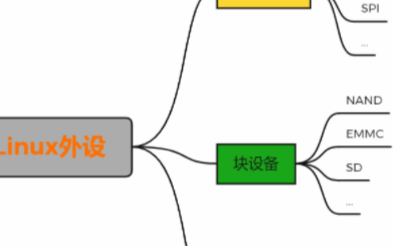
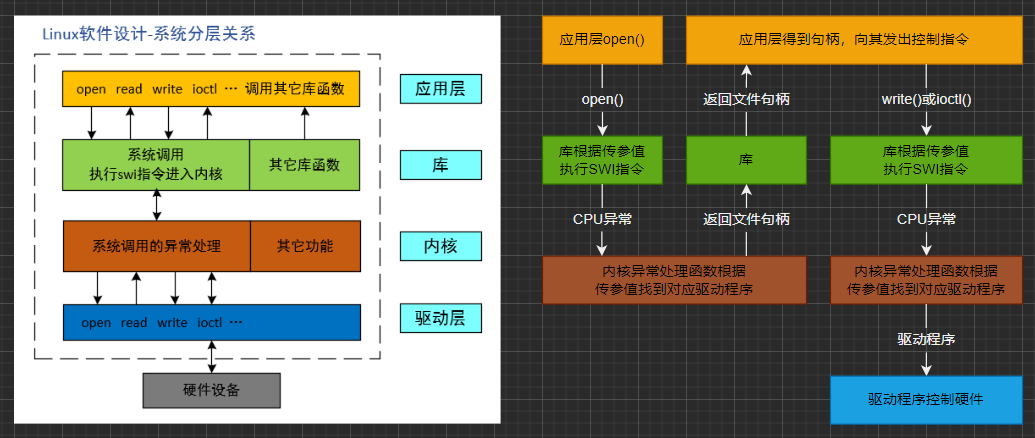



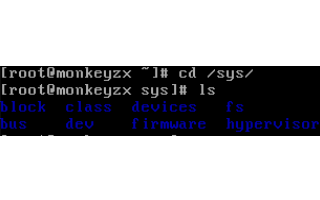
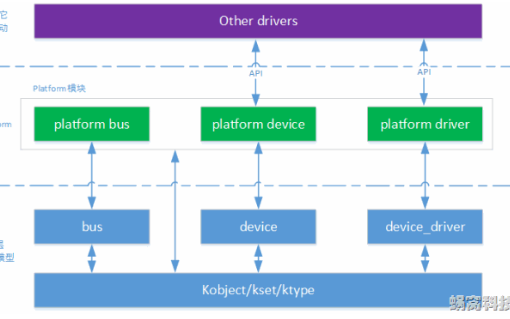

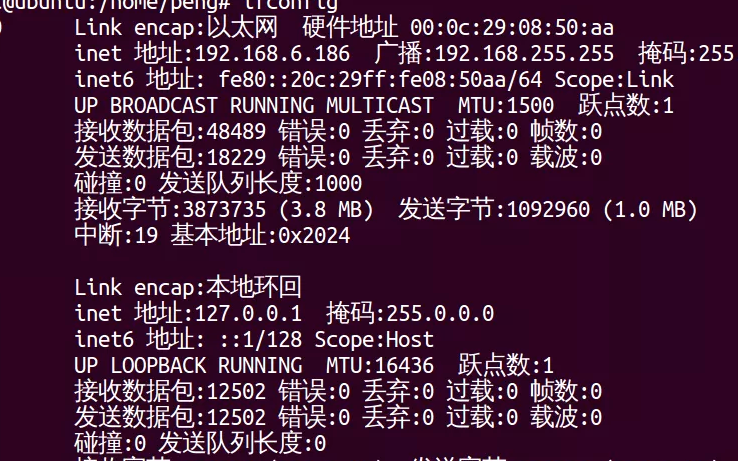
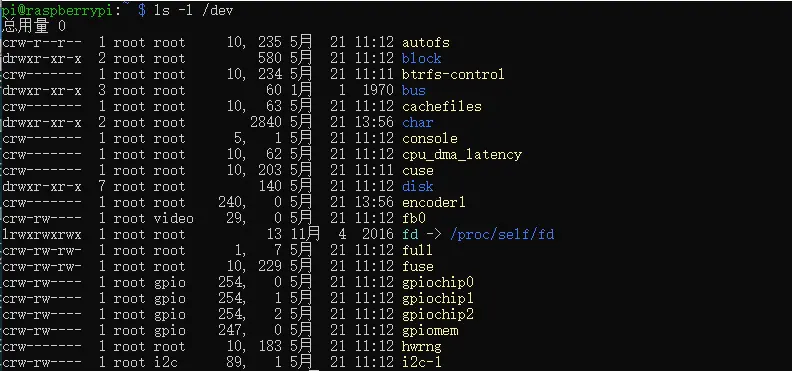
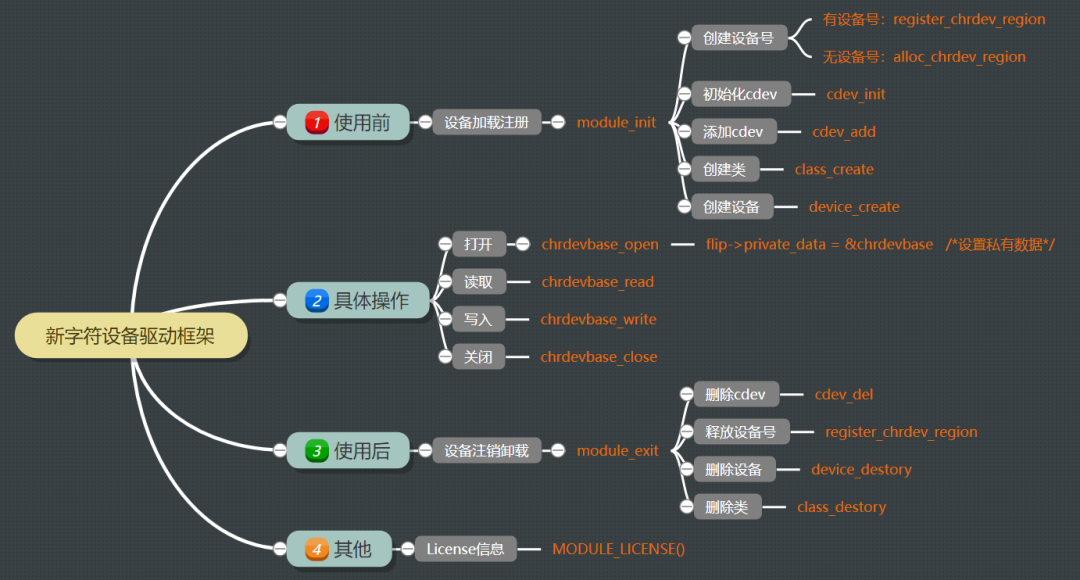
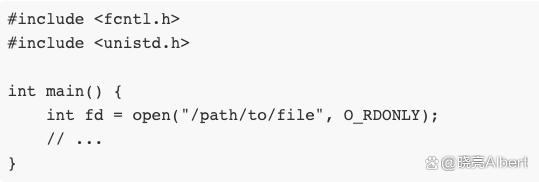










評論